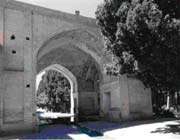Old Houses in Kashan
Old houses in Kashan are the symbol of traditional architecture of deserts because they have special secretive design which are exclusive to deserts. Simple halls, high and secure walls and their portals depict the old houses of this 7000-year-old city with its calm, pleasant and enjoyable atmosphere.
Borujerdi House
Borujerdi House was built in the mid 13th century (A. H. Lunar) in the district of Sultan Mir Ahmad. The founder of the house was Hadj Seyyed Hassan Borujerdi who was one of the businessmen of Natanz and lived in Kashan. The architect was Master AN Maryam Kashani. At the time of its building, the art of painting, architecture was at the highest. Some of the paintings of the big hall are drawn by Master Kamal-ul Molk. Since Kama-ul Molk left Kashan when he was 15 years old, so these paintings are before his departure. Perhaps no other house could be found in Kashan which has the quality of the paintings of this house.
Aran and Bidgol: the City of Domes
According to the Islamic geographers, Kashan was also known as Chehel Hesaran. When ancient Sialk Hills were ruined, many big and small villages were established in the shape of castles and fortresses so the place was called Chehel Hesaran. Aran and Bid Gol are of those 40 fortresses which were used as the first settlements for the people of the world. The origin of the word Aran is from Aryan, the other name for Arya (means the holy place) and Bid Gol originates from BiBi Gol or ViGol.
Aran and Bid Gol (with the area of 6051 sq km) are located in the northern region of Isfahan Province. This area which is known as the gem of desert limits to salt lake and Ghom and Semnan provinces from north, to Natanz and Ardestan from east and to historical city of Kashan from west and south. Husbandry is not that much common in this region and the main products are summer vegetables such as water melon or carrots, cucumbers, turnips, etc. Weaving carpet is very common and these carpets are known as "Kashani Carpets" in bazaar. Aran and Bid Gol are considered as some of the richest and important tourist attractions of the Province. The beautiful and fantastic desert of this region with its winding lanes and passages that reach to some central squares is memorable for every viewer. This ancient city with its two big regions has 29 districts and the existence of some mausoleums, shrines, Hosseiniehs, mosques with domes and minarets have given it a kind of spiritual atmosphere.

Fin Garden
It is a very green and beautiful garden which sparkles like a star in the desert. Many beautiful and regularly streams of water are running in it. Shotor Galuye Abbasi is one of the valuable and important monuments of the Safavids which is located in the center of the garden and was known as central pool. Since the shape of this pool is similar to the neck of camel it is known as Shotor Galu (camel's neck). Soleymanieh spring which is the main water resource for the pool is at the rear of traditional tea house of Fin Garden. The famous Fin Bath is located inside the garden. Although the architecture of Fin Bath is very simple but it is very dazzling. Inside the interconnected halls and passages of the bath you can feel betrayal (referring to the murder of the powerful counselor of Iran, Amir Kabir who was first exiled to this garden and then murdered in the bath by the order of King Nasereddin Shah). As you move ahead you feel this betrayal and treachery more.
Sultan Amir Ahmad Bath
Sultan Amir Ahmad Bath is located beside the mausoleum of Imam Zadeh Sultan Amir Ahmad, one of the great grand children of Imam Javad. This historical bath is one of most beautiful bathes of Iran from architectural point of view, its decoration and the use of the space. It goes back to the Safavids and is made of two parts and each part has locker room or changing room. The roof of the bath is made of some domes and it is considered as one of the most beautiful dome shaped roofs in Iran and above each dome there is a convex glass in order to make enough light for different parts of the bath. The bath not only has a unique architecture but also displays a valuable sample of Safavid artistic works of painting and plaster. The bath was ruined because of an earthquake but it was rebuilt later.